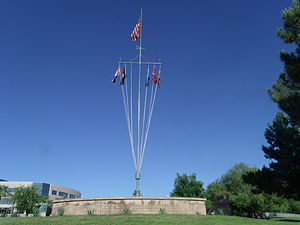
The United Daughters of the Confederacy (UDC) is an American neo-Confederate hereditary association for female descendants of Confederate Civil War soldiers engaging in the commemoration of these ancestors, the funding of monuments to them, and the promotion of the pseudohistorical Lost Cause ideology and corresponding white supremacy.

USS Arizona was a battleship built for the United States Navy in the mid-1910s. Named in honor of the 48th state, she was the second and last ship in the Pennsylvania class. After being commissioned in 1916, Arizona remained stateside during World War I but escorted President Woodrow Wilson to the subsequent Paris Peace Conference. The ship was deployed abroad again in 1919 to represent American interests during the Greco-Turkish War. Two years later, she was transferred to the Pacific Fleet, under which the ship would remain for the rest of her career.

USS Utah (BB-31/AG-16) was the second and final member of the Florida class of dreadnought battleships. The first ship of the United States Navy named after the state of Utah, she had one sister ship, Florida. Utah was built by the New York Shipbuilding Corporation, laid down in March 1909 and launched in December of that year. She was completed in August 1911, and was armed with a main battery of ten 12-inch (305 mm) guns in five twin gun turrets.
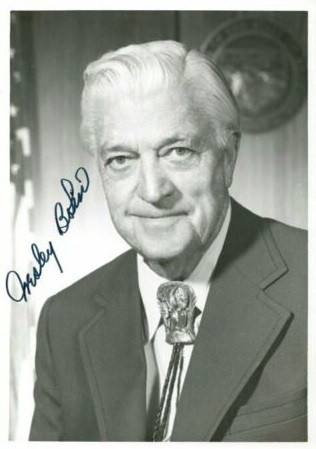
Wesley Bolin was an American Democratic Party politician who served as the 15th governor of Arizona between 1977 and 1978. His five months in office mark the shortest term in office for any Arizona governor. Prior to ascending to the Governorship, Bolin was the longest serving Secretary of State of Arizona, serving 28 years from 1949 until he succeeded to the governorship in 1977 following the resignation of his predecessor.
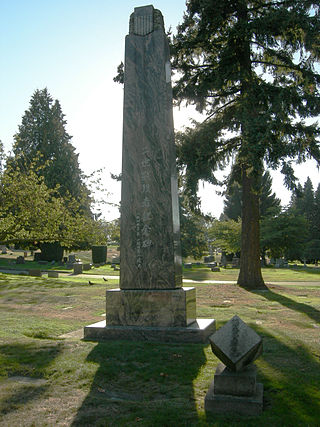
Lake View Cemetery is a private cemetery located in Seattle, Washington, in the Capitol Hill neighborhood, just north of Volunteer Park. Known as "Seattle's Pioneer Cemetery," it is run by an independent, non-profit association. It was founded in 1872 as the Seattle Masonic Cemetery and later renamed for its view of Lake Washington to the east.
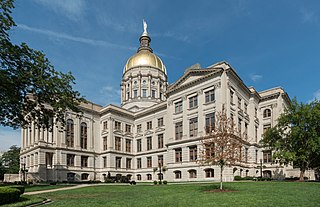
The Georgia State Capitol is an architecturally and historically significant building in Atlanta, Georgia, United States. The building has been named a National Historic Landmark which is listed on the National Register of Historic Places. As the primary office building of Georgia's government, the capitol houses the offices of the governor, lieutenant governor, and secretary of state on the second floor, chambers in which the General Assembly, consisting of the Georgia State Senate and Georgia House of Representatives, meets annually from January to April. The fourth floor houses visitors' galleries overlooking the legislative chambers and a museum located near the rotunda in which a statue of Miss Freedom caps the dome.

The Arkansas State Capitol, often called the Capitol Building, is the home of the Arkansas General Assembly, and the seat of the Arkansas state government that sits atop Capitol Hill at the eastern end of the Capitol Mall in Little Rock, Arkansas.

The Arizona State Capitol in Phoenix, Arizona, United States, was the last home for Arizona's Territorial government, until Arizona became a state in 1912. Initially, all three branches of the new state government occupied the four floors of the statehouse. As the state expanded the branches relocated to adjacent buildings and additions. The 1901 portion of the Capitol is now maintained as the Arizona Capitol Museum with a focus on the history and culture of Arizona. The Arizona State Library, which occupied most of the 1938 addition until July 2017, re-opened in late 2018 as a part of the Arizona Capitol Museum.

The South Carolina State House is the building housing the government of the U.S. state of South Carolina, which includes the South Carolina General Assembly and the offices of the Governor and Lieutenant Governor of South Carolina. Located in the capital city of Columbia near the corner of Gervais and Assembly Streets, the building also housed the Supreme Court until 1971.

The 14"/45 caliber gun,, whose variations were known initially as the Mark 1, 2, 3, and 5, and, when upgraded in the 1930s, were redesignated as the Mark 8, 9, 10, and 12. They were the first 14-inch (356 mm) guns to be employed with the United States Navy. The 14-inch/45 caliber guns were installed as the primary armament aboard all of the United States Navy's New York-class, Nevada-class, and Pennsylvania-class battleships. The gun also saw service in the British Royal Navy, where it was designated the BL 14 inch gun Mk II.

Salvaged artifacts from the USS Arizona, a battleship that was catastrophically sunk during the 1941 attack on Pearl Harbor, are displayed in several locations around the United States.
Ten Commandments Monument may refer to:
More than 100 monuments and memorials to the Confederate States of America and associated figures have been removed, all but five since 2015. Some have been removed by state and local governments; others have been torn down by protestors.
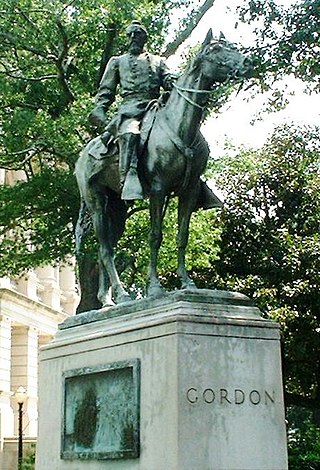
The equestrian statue of John Brown Gordon is a monument on the grounds of the Georgia State Capitol in Atlanta, Georgia, United States. The monument, an equestrian statue, honors John Brown Gordon, a general in the Confederate States Army during the American Civil War who later become a politician in post-Reconstruction era Georgia. Designed by Solon Borglum, the statue was dedicated in 1907 to large fanfare. The statue has recently become a figure of controversy over Gordon's racist views and associations with the Confederacy, with some calling for its removal.
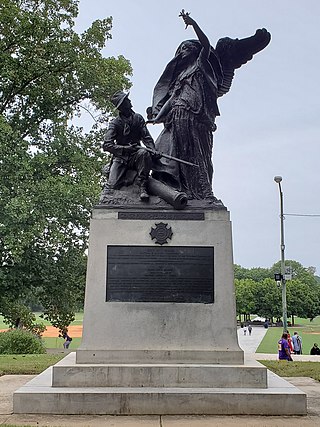
The Peace Monument is a public monument in Atlanta, Georgia, United States. Designed by Allen George Newman, the monument is located in Piedmont Park and was erected in 1911 by members of the Old Guard of the Gate City Guard, a Confederate-era militia, as a show of national unity in the years following the American Civil War. The monument has been the subject of controversy recently, with some calling for its removal as a symbol of the Lost Cause of the Confederacy.
